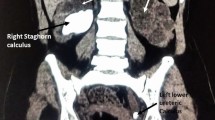Abstract
Purpose
In view of the differences in early and late management experiences based on Huang and Tseng CT classification of emphysematous pyelonephritis (EP), our study included 34 patients aimed to re-correlate the current management plans with CT classification.
Methods
A retrospective review from January 2009 to December 2018, in patients with primary or final diagnosis of EP. Data included; patients’ demographics, routine laboratory and imaging work-up. CT was performed for all, and images were classified based on Huang and Tseng classification. The CT classification was correlated to the laboratory parameters and the final treatment plans. Data were collected and analyzed using SPSS®.
Results
Complete data for 34 patients were analyzed. The majority (70%) had positive urine culture, and Carbapenems and Ureidopenicillin were the most commonly used antibiotics. Based on CT classification, 75% (26/34) of the patients were in class I and II, 6 cases with class IIIa, and only two with class IIIb, with no cases of class IV. All patients in class I and II responded well to the medical therapy, and eight required PCN/DJ. Four required nephrectomy in class III, with zero mortality.
Conclusion
Patients in class I and II comprise the majority of EP patients, and respond well to medical treatment with excellent outcome. Insertion of PCN and DJ are not required routinely, but with urinary obstruction requiring drainage, and a few cases who required nephrectomy–all with class III. Our data show improvement in the overall survival in patients for EP.




Similar content being viewed by others
References
Falagas ME, Alexiou VG, Giannopoulou KP, Siempos II (2007) Risk factors for mortality in patients with emphysematous pyelonephritis: a meta-analysis. J Urol 178(3 Pt 1):880–885 (quiz 1129 )
Huang JJ, Tseng CC (2000) Emphysematous pyelonephritis: clinicoradiological classification, management, prognosis, and pathogenesis. Arch Intern Med 160(6):797–805
Saadi A, Ayed H, Bouzouita A, Cherif M, Kerkeni W, Selmi S et al (2016) Results of conservative management of emphysematous pyelonephritis. Nephrol Ther 12(7):508–515 (Resultats du traitement conservateur de la pyelonephrite emphysemateuse. fre)
Eswarappa M, Suryadevara S, John MM, Kumar M, Reddy SB, Suhail M (2018) Emphysematous pyelonephritis case series from south India. Kidney Int Rep 3(4):950–955
Sharma PK, Sharma R, Vijay MK, Tiwari P, Goel A, Kundu AK (2013) Emphysematous pyelonephritis: our experience with conservative management in 14 cases. Urol Ann 5(3):157–162
Kuchay MS, Laway BA, Bhat MA, Mir SA (2014) Medical therapy alone can be sufficient for bilateral emphysematous pyelonephritis: report of a new case and review of previous experiences. Int Urol Nephrol 46(1):223–227
Shokeir AA, El-Azab M, Mohsen T, El-Diasty T (1997) Emphysematous pyelonephritis: a 15-year experience with 20 cases. Urology 49(3):343–346
Misgar RA, Mubarik I, Wani AI, Bashir MI, Ramzan M, Laway BA (2016) Emphysematous pyelonephritis: a 10-year experience with 26 cases. Indian J Endocrinol Metab 20(4):475–480
Khaira A, Gupta A, Rana DS, Gupta A, Bhalla A, Khullar D (2009) Retrospective analysis of clinical profile prognostic factors and outcomes of 19 patients of emphysematous pyelonephritis. Int Urol Nephrol 41(4):959–966
Das D, Pal DK (2016) Double J stenting: a rewarding option in the management of emphysematous pyelonephritis. Urol Ann 8(3):261–264
Sokhal AK, Kumar M, Purkait B, Jhanwar A, Singh K, Bansal A et al (2017) Emphysematous pyelonephritis: changing trend of clinical spectrum, pathogenesis, management and outcome. Turk J Urol 43(2):202–209
Pontin AR, Barnes RD (2009) Current management of emphysematous pyelonephritis. Nat Rev Urol 6(5):272–279
Aboumarzouk OM, Hughes O, Narahari K, Coulthard R, Kynaston H, Chlosta P et al (2014) Emphysematous pyelonephritis: time for a management plan with an evidence-based approach. Arab J Urol 12(2):106–115
Author information
Authors and Affiliations
Corresponding author
Ethics declarations
Conflict of interest
None of the authors has conflict of interest.
Additional information
Publisher's Note
Springer Nature remains neutral with regard to jurisdictional claims in published maps and institutional affiliations.
Rights and permissions
About this article
Cite this article
Elawdy, M.M., Osman, Y., Abouelkheir, R.T. et al. Emphysematous pyelonephritis treatment strategies in correlation to the CT classification: have the current experience and prognosis changed?. Int Urol Nephrol 51, 1709–1713 (2019). https://doi.org/10.1007/s11255-019-02220-3
Received:
Accepted:
Published:
Issue Date:
DOI: https://doi.org/10.1007/s11255-019-02220-3




